Mesclun – How to Grow a Salad
Mesclun is easy to grow in the early spring and is ideal for close planting in a raised bed garden or in a container.
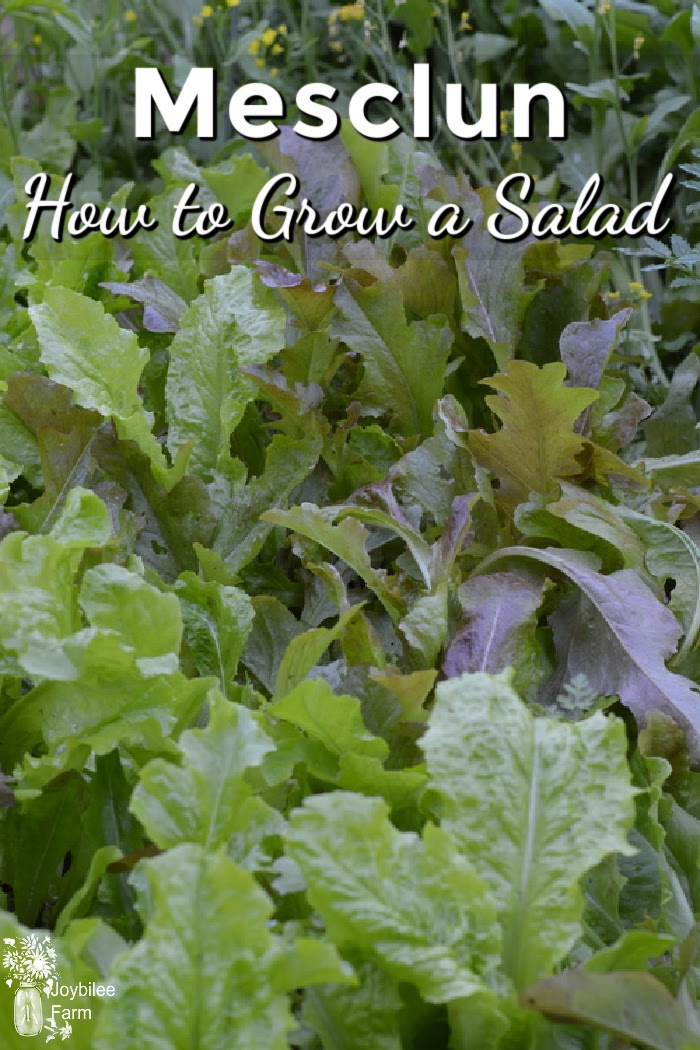
I used to love those plastic cartons of spring greens that you can get at the grocery store. The baby lettuce leaves, spinach, and kale are triple washed and sold at a premium price. They are easy to use. Just dump into the salad bowl and add dressing. But with my family of 3, we usually waste half the carton, as we can’t seem to eat it before the leaves get slimy. In fact, sometimes the leaves are slimy when we bring them home from the store. Chalk it up to living far from the distribution point. They are also pricey, so I only buy them in winter, when my garden is buried in snow and my micro-greens aren’t producing. Here we pay about $6 for 300 grams. But since about half is wasted that’s actually $6 for 150 grams. (Yikes!) I won’t even get into the ethics of organic produce packaged in plastic and trucked thousands of miles before it gets to my store.
But now you understand why I started growing microgreens.
Grow your own mesclun
The mixture of tender baby leaves is called “mesclun,” meaning “mixture.” The traditional French mesclun mix contains chervil, arugula, endive, red and green lettuces in equal proportions. Today Mesclun could be spicy herbs, lettuce, Chinese greens, or even weeds.
Did you know that you can grow your own? Mesclun is ideal for close planting in a raised bed garden or in a container. One package of 25 grams of seed is about the price of just one of those fancy clear plastic salad tubs, and with that package of seed, you can eat all summer long. You can even plant them as microgreens, under a grow light in the winter. From planting to your first harvest is just 3 to 4 weeks, depending on the seeds in the mixture.
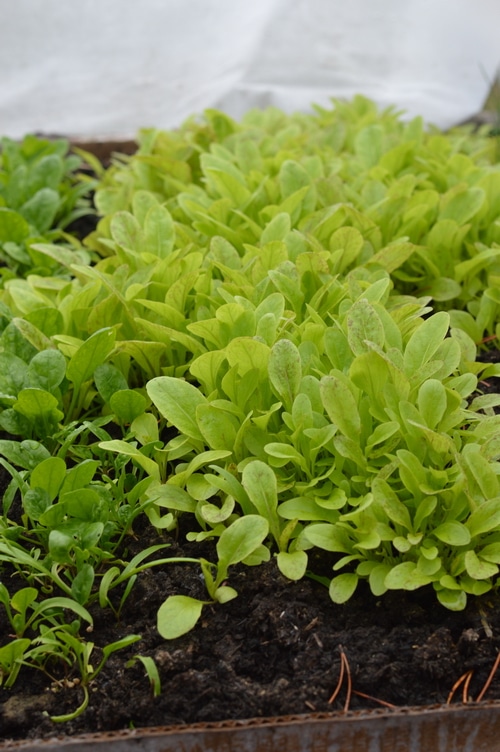
Mesclun is a mixture of tender lettuces, herbs, spinach, kale, and other greens that grow quickly in cool weather. They grow close together and grow in a mass from one planting. Harvest them when they are about 5 inches tall. To harvest them you simply use a pair of shears and clip all the leaves about 2 inches from the ground. Alternatively, you can harvest individual leaves from each plant, leaving the centre leaves to nourish the root. I’ve done it both ways. The plants will regrow in 2 to 3 weeks and can be harvested again. If the weather stays cool you can harvest them up to 3 times or even pull up individual plants and transplant them out at proper spacing, for a more extensive harvest.
We are cool all summer long and don’t usually have trouble growing lettuce, but often after the second clip, my mesclun gets too damp and I begin to lose some to bacterial wilt. If I ate it faster, it wouldn’t be a problem. At this point, I pull out the last of the mesclun and plant the bed or container freshly for another harvest in about 4 weeks.
When we used to sell vegetables at the farmer’s market, mesclun was our number 1 seller. We could still grow it when the farmers in the valley had given up on lettuce for the season due to the heat. That gave us a corner on the baby greens market locally, for a few summers.
At Joybilee Farm we grow mesclun in our raised bed garden. It does especially well in the hugelkultur bed. The extra height increases the air circulation and protects it from nighttime cold air, which prevents dampness and bacterial wilt.
The key to an abundant harvest of mesclun is to choose your seed well and scatter thickly, about 360 seeds per square foot.
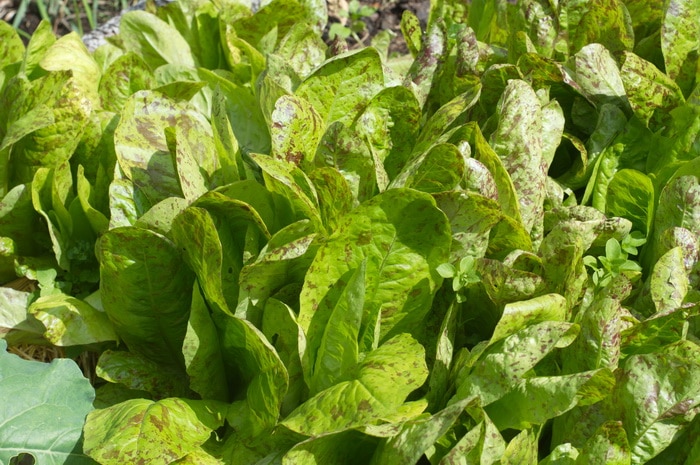
What to plant for mesclun
While you could technically mix your own mesclun seed for your garden, commercial blends are mixed so that there is a variety of lettuce, herbs, kale, and chard with similar growth rates. Lettuce varies in its time from planting to maturity. A glance through the seed catalogue lists anywhere from 31 to 80 days for maturity dates for lettuces. Ideally, you want all the seeds in your mesclun mix to grow at the same rate so that they recover for the second cutting at the same speed.
To achieve this pick lettuce varieties within a window of 10 days to maturity for your custom mesclun mix. Butterhead lettuces for instance can mature anywhere from 50 to 70 days. If you plant “Speckled Butterhead” an attractive freckled butterhead that matures in 50 days, you’ll want to pair it with another red lettuce that matures in the same window. A good pick would be “Red Salad Bowl” loose-leaf lettuce that matures in 55 days or “Merlot” a brilliant wine red, frilly looseleaf with 55 days maturity. Green lettuce will bring out the red colours perfectly. Salad Bowl is an oak leaf type that matures in 60 days but will give you baby leaves about the same time as these other two varieties.
Red Russian Kale also matures within the window of these lettuces and would be a good choice to add to this blend for added texture and interest. Consider adding curly cress (10 days to maturity) or Edible Chrysanthemum (45 days to maturity) to your blend for extra spice and texture.
This is a simple method for determining a mixture of leaf colours, tastes, textures, and shapes for making up your own mesclun seed mix. If you are an adventurous gardener play with the math and create your own unique mesclun blend that suits your own palate.
If you would rather save the guesswork, most seed catalogues now carry a good selection of pre-mixed mesclun blends. They’ve already done the difficult planning for you.
What you can find in the seed catalogues
I love getting inspiration from the seed catalogues. West Coast seed offers 11 different mesclun mixtures from lettuce spring mix, to a spicy winter hardy blend, to a stir fry blend of Asian greens. The mixtures can be planted in your spring or fall garden or planted in containers on your balcony or porch. Lettuce doesn’t need full sun and in fact, will do better in the dappled shade after July 1st.
Baker Creek Seed offers 4 salad blends from Rocky Top Lettuce Salad to Siamese Dragon Stir-Fry mix. Each packet contains only 1000 seeds though, or enough for 3 square feet of garden space. A 1 oz package from Baker Creek will satisfy your mesclun cravings for the season and give you lots to plant for microgreens next winter.
My other favourite seed company, William Dam Seeds has just 3 varieties of mesclun under their Salad Mixtures heading on p. 40 of their 2015 catalogue. One is a mixture of hot weather lettuces, picked to flourish in the summer heat, and ready to harvest as a cut and come again salad at just 25 days. Just enough time to grow some easter egg radishes to serve with the salad. A 25 gram package from William Dam will give you plenty of seeds to resow several times this summer and also give you lots of microgreens this winter. This morning I planted William Dam’s Mesclun Salad Mixture in my hugelkultur bed — a blend of curly endive, chervil, arugula, chicory, chard, and colourful lettuce.
How to plant Mesclun in your raised bed garden
There are two ways you can plant mesclun mixtures. Which you should choose depends on how much water your garden gets in the early spring. If you expect a lot of rain, planting in rows will give your plants air circulation which may prolong the harvest a few more weeks. If you are on the dry side, planting more thickly will shade the ground and allow more moisture retention. The deep taproots of lettuce will mean that once your greens get established you won’t have to water as frequently.
To plant mesclun in rows, define a straight row with a string and drag the edge of a tool along the soil in line with the string to make a 1/2 to 1 inch depression. Sprinkle your seed in the depression, at a rate of 4 to 6 seeds per inch of row. Cover loosely with dirt. Press the soil firmly in place in the row. Plant rows 4 to 6 inches apart. Mulch between the rows to suppress weeds and retain soil moisture.
Since we are on the dry side right now, I planted my mesclun by scattering a generous amount of mesclun seed over a 3 feet square spot on a large raised bed. After scattering the seed over the soil surface, I gently raked the area with my fingers to cover the seed lightly. Seed that isn’t covered will still germinate. They will be ready to harvest around May 15th and then again around June 7th. Then I’ll pull them out and replant this bed with pickling cukes. In a shadier part of my forest garden, in another hugelkultur bed, I planted the same mesclun seeds but in rows. I planted them thickly down the row but left a 4 to 6 inch spacing between the rows. This will allow air circulation between the plants which I hope will allow me to have a longer harvest from this bed, which receives dappled shade and afternoon sun in the middle of July.
How to plant mesclun in your container garden
Containers need more attention than an outdoor garden. Watering, especially, can be a challenge when the weather turns hot. The more plants you have in a container, the more often you’ll need to water. In especially hot summer, you may need to water two or three times a day. By spacing the seed a little further apart — say one seed in each square inch of surface soil, you can balance this water dance. Mesclun grown in containers is usually cleaner, with less weed contamination than mesclun grown in garden soil. There are advantages to using fast-growing mesclun in a planter instead of directly in garden soil.
Watering needs
Once you plant your seeds, you’ll need to water them in well, if you don’t expect rain. The bed should receive 2 inches of rain per week. If rain is lacking, watering with drip irrigation beside the rows will make watering more efficient, and prolong the life of your lettuce bed. Bacterial wilt is more destructive with overhead watering practices. If you planted your mesclun by broadcasting the seed over a few square feet, plan to use overhead watering, but avoid watering after 6 pm, so that the leaves have a chance to dry before nightfall and cooler temperatures.
Get ready to harvest
Your mesclun is ready to harvest when it is 4 to 6 inches high, at the baby leaf stage. To harvest take the outer leaves, by pinching them off at the base of each rosette, or just cut them off with scissors, leaving 2 inches of the plant to regrow.
After the first harvest, you can thin your bed by lifting out the strongest plants and transplanting them 6 inches apart in rows 1 foot apart, and grow out some mature leaf lettuces. While you are waiting for these plants to mature, continue harvesting your mesclun every 3 to 4 weeks. In a cool year, you may get 3 or 4 harvests before you have to clear it out and replant.

If you have more harvest than you can eat check out this post on how to make super greens supplement powder for vitamins and minerals year-round. Put your excess harvest into super greens supplements and add it to your winter soups, vegetable juices, and smoothies for an extra nutritional boost year-round. You’ll save money and improve your nutrition, as well as make better use of your resources. Win-win!
Isn’t that a better value than 300 grams in a plastic box for $6?
Your Turn:
Let me know what you do with the excess baby greens and lettuces that you get. I’d love some fresh ideas of how to use up this homestead abundance.


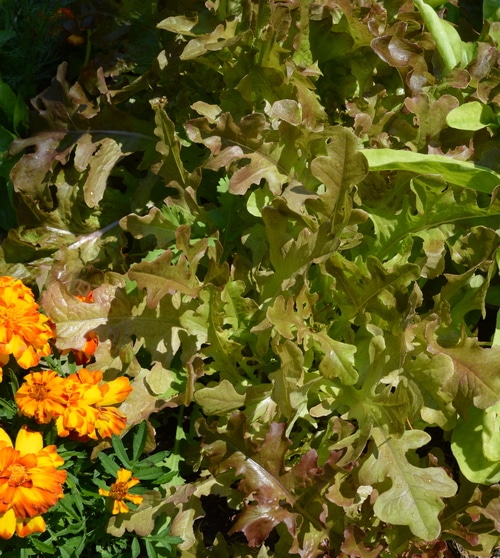

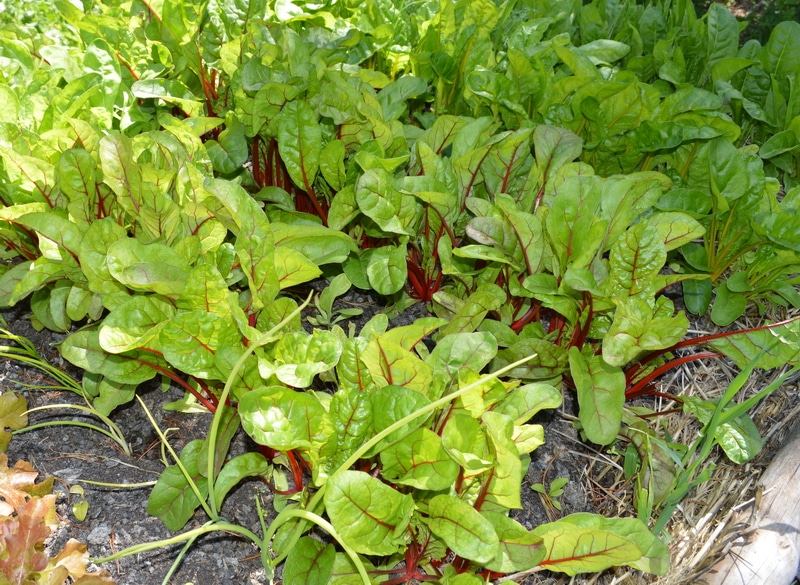

I used the Mescuiln Mix in my minestrone, I put in the hamburgers I BBQ’d. I mixed it in my salad. Any place I could use it I did. Lol,, My father-in-law and my hubby weren’t big green eaters. My fav salad greens. Ever. My Dad called it weed salad. Lol Hecer passed between his lips.
Can you include head lettuce in you mind or should that really be planted on its own? We are doing a salad bar off the kitchen this year and mesclun would be a great way to edge the bed.
Head lettuce takes longer to mature than the other kinds of lettuce and it also needs more space. So you could start it with the other mesclun lettuces but you’d want to transplant it out at better spacing once it was 4 leaves big.
Eventually I’m going to do this! It’s been years since I planted a salad garden. Thanks for the tips.
Great post! We are towards the end of our greens season – it’s been in the 80s here. But I’m still harvesting kale and swiss chard to eat and to dehydrate.
I should be jealous, but I know that in July, when I’m just beginning to harvest my chard and I’m planting my second run of lettuce, you’ll be sitting beside the air conditioning sipping ice tea. I love the saying in the Little House books — “The rich get their ice in the summer and the poor get theirs in the winter.” I know not quite the same situation, but sorta.